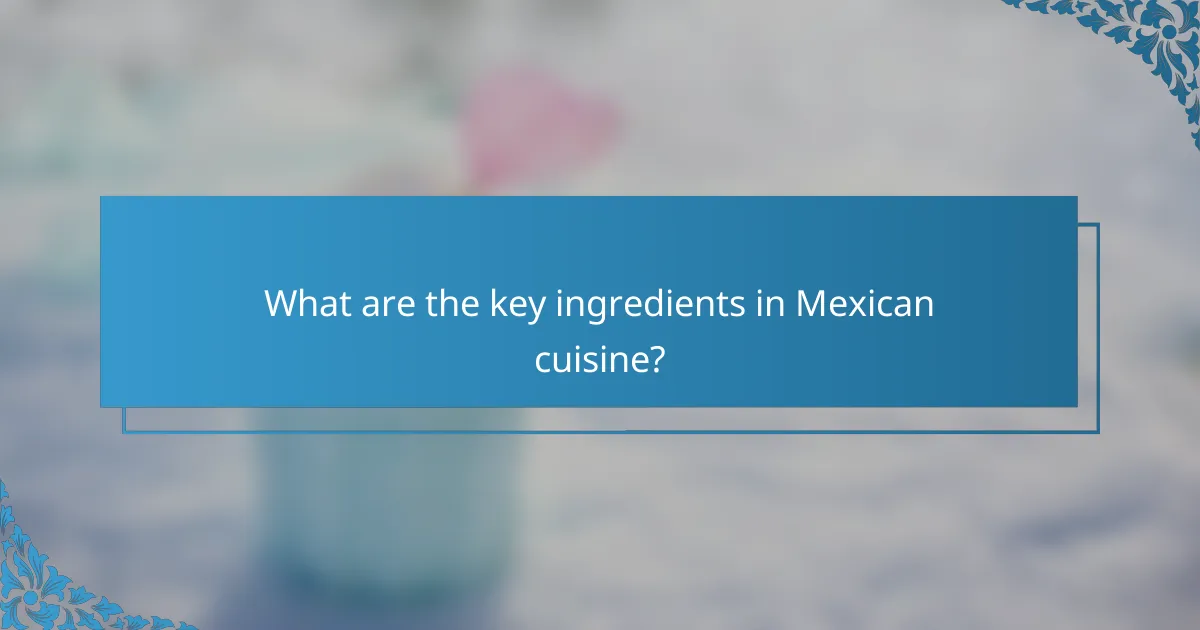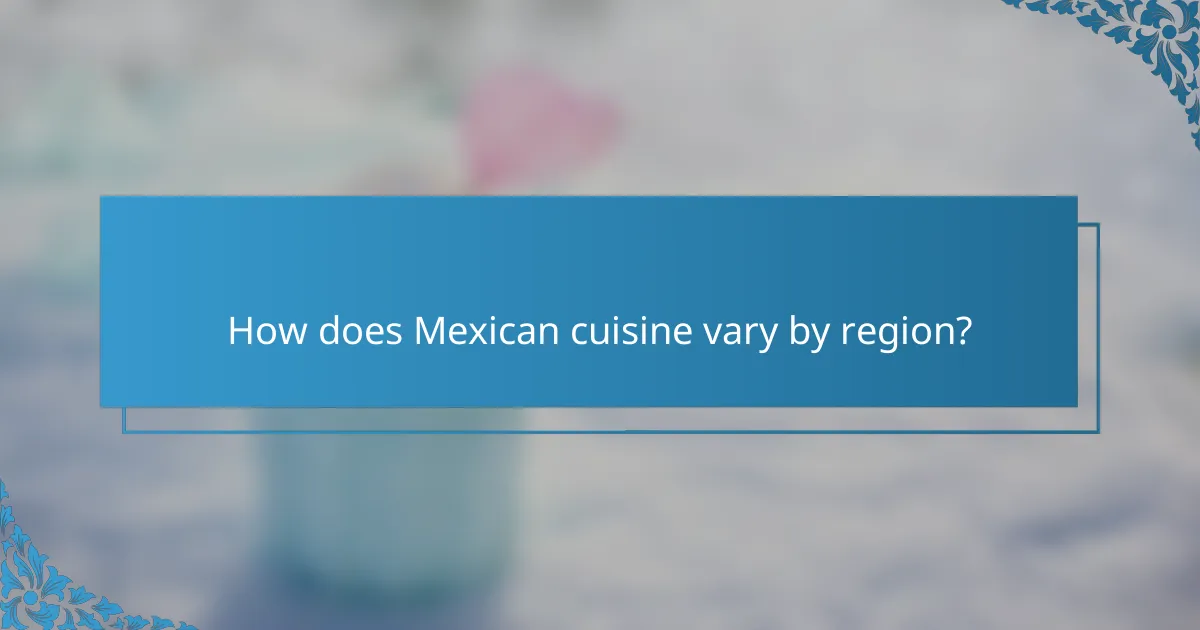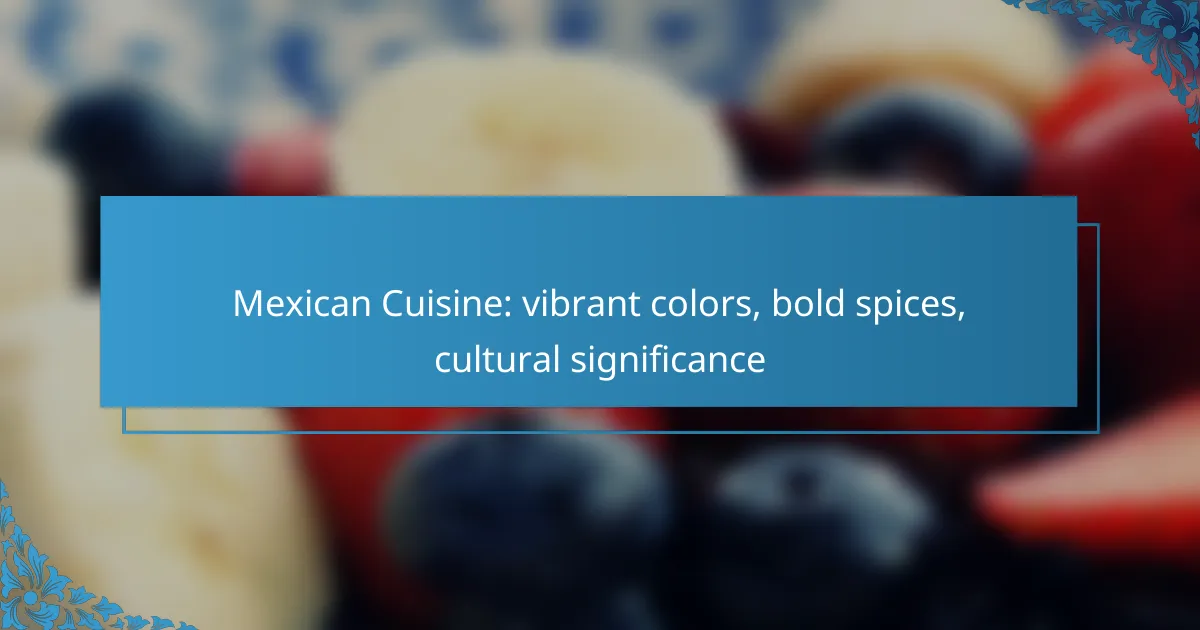Mexican cuisine is a vibrant tapestry of bold flavors and rich cultural significance, characterized by its use of fresh ingredients and a variety of spices. From the colorful dishes that grace the tables to the traditional techniques passed down through generations, each meal tells a story of heritage and community. Exploring this culinary landscape reveals not only the diverse ingredients like chiles and corn but also the deep-rooted traditions that make Mexican food a celebration of life and culture.

What are the best Mexican restaurants in Los Angeles?
Los Angeles boasts a vibrant Mexican dining scene, with numerous restaurants offering authentic flavors and unique culinary experiences. Some of the standout options include Guelaguetza, La Casita Mexicana, and El Cholo, each known for their distinct dishes and cultural significance.
Guelaguetza
Guelaguetza is renowned for its Oaxacan cuisine, showcasing traditional dishes like mole and tlayudas. The restaurant emphasizes the use of fresh, high-quality ingredients, often sourced from local markets, which enhances the authenticity of its offerings.
When visiting Guelaguetza, consider trying their famous mole negro, a rich sauce made from a blend of spices and chocolate. The vibrant atmosphere, complete with colorful decor, reflects the cultural heritage of Oaxaca, making it a memorable dining experience.
La Casita Mexicana
La Casita Mexicana is celebrated for its home-style cooking and warm ambiance, offering a menu filled with classic Mexican dishes. The restaurant prides itself on using traditional recipes passed down through generations, ensuring an authentic taste of Mexico.
Popular items include their enchiladas and chiles en nogada, which are prepared with care and attention to detail. The restaurant’s commitment to quality and flavor has earned it a loyal following among locals and visitors alike.
El Cholo
El Cholo is a Los Angeles institution, known for its rich history and classic Mexican fare. Established in the 1920s, it has become a go-to spot for both casual diners and special occasions, offering a diverse menu that caters to various tastes.
Be sure to try their signature margaritas and the famous green corn tamales, which highlight the restaurant’s dedication to traditional Mexican flavors. The lively atmosphere and friendly service make El Cholo a perfect place to enjoy a meal with family and friends.

How to prepare traditional Mexican dishes?
Preparing traditional Mexican dishes involves using fresh ingredients, bold spices, and authentic techniques. Focus on mastering key recipes and understanding the cultural significance behind each dish to fully appreciate the vibrant flavors of Mexican cuisine.
Recipes for Tacos al Pastor
Tacos al Pastor are a beloved Mexican street food known for their marinated pork and pineapple. To make them, start with thinly sliced pork shoulder marinated in a blend of spices, including achiote, garlic, and vinegar, then cook it on a vertical spit or grill.
Once the meat is cooked, slice it thinly and serve it on warm corn tortillas. Top with diced onions, cilantro, and a squeeze of lime for a refreshing finish. For an authentic touch, consider adding grilled pineapple chunks.
Steps to make Mole Poblano
Mole Poblano is a rich, complex sauce that combines various ingredients, including chiles, chocolate, nuts, and spices. Begin by toasting dried chiles like ancho and guajillo, then blend them with garlic, onions, and tomatoes to create a smooth paste.
Next, cook the paste with broth and other ingredients such as sesame seeds and dark chocolate. Allow the mole to simmer for an extended period to develop its deep flavors. Serve it over chicken or turkey for a traditional experience, and pair it with rice or tortillas to balance the richness.

What are the key ingredients in Mexican cuisine?
The key ingredients in Mexican cuisine include a variety of chiles, spices, corn, beans, and fresh herbs. These elements create the vibrant flavors and colorful dishes that are characteristic of this culinary tradition.
Chiles and spices
Chiles are fundamental to Mexican cuisine, providing heat and depth to dishes. Varieties such as jalapeño, poblano, and habanero each offer unique flavors and heat levels, ranging from mild to extremely spicy.
Spices like cumin, oregano, and cinnamon enhance the complexity of Mexican dishes. Using these spices in moderation can elevate flavors without overwhelming the palate.
Corn and beans
Corn is a staple in Mexican cooking, often used in tortillas, tamales, and various side dishes. It serves as a versatile base for many meals and is a key component of traditional diets.
Beans, particularly black and pinto varieties, are another essential ingredient. They are rich in protein and fiber, making them a nutritious complement to corn and a foundation for many classic dishes like refried beans and bean soups.
Herbs like cilantro
Fresh herbs, especially cilantro, add brightness and freshness to Mexican cuisine. Cilantro is commonly used in salsas, guacamole, and as a garnish, enhancing the overall flavor profile of dishes.
Other herbs, such as epazote and oregano, are also used but in smaller quantities. These herbs can provide distinctive flavors that are integral to regional specialties, making them worth exploring in various recipes.

What is the cultural significance of Mexican cuisine?
Mexican cuisine holds deep cultural significance, reflecting the country’s history, traditions, and regional diversity. It serves as a vital link between generations, showcasing the vibrant colors and bold spices that characterize its dishes.
Connection to family traditions
Mexican cuisine is often intertwined with family traditions, where recipes are passed down through generations. Meals are typically prepared together, fostering bonds and creating lasting memories. For instance, the preparation of tamales during the holiday season is a communal activity that brings families together.
Many families have unique recipes that reflect their regional heritage, emphasizing the importance of local ingredients and cooking methods. This connection to tradition not only preserves culinary skills but also reinforces cultural identity.
Role in celebrations and festivals
Food plays a central role in Mexican celebrations and festivals, marking significant events such as Día de los Muertos and Christmas. Traditional dishes like mole, pozole, and pan de muerto are often prepared to honor these occasions, showcasing the rich flavors and cultural heritage of Mexico.
During festivals, communal meals are common, where families and friends gather to share food and celebrate together. This practice strengthens community ties and highlights the importance of food in social interactions, making it a cornerstone of Mexican cultural life.

How does Mexican cuisine vary by region?
Mexican cuisine is diverse and varies significantly by region, influenced by local ingredients, climate, and cultural traditions. Each area showcases unique flavors, cooking techniques, and signature dishes that reflect its history and geography.
Oaxacan specialties
Oaxaca is renowned for its rich culinary heritage, featuring a variety of moles, which are complex sauces made from a blend of ingredients including chiles, spices, and chocolate. Tlayudas, large tortillas topped with beans, cheese, and meats, are also a staple in this region.
Another highlight of Oaxacan cuisine is the use of indigenous ingredients such as corn and various types of chiles. The region is famous for its artisanal mezcal, a traditional spirit made from agave, which complements many local dishes.
Yucatecan flavors
Yucatán cuisine is characterized by its use of citrus, particularly sour oranges, and spices like achiote, which gives dishes a distinct color and flavor. Cochinita pibil, a slow-roasted pork dish marinated in achiote and wrapped in banana leaves, is a signature offering.
In addition to cochinita pibil, Yucatán is known for its refreshing ceviches and salsas that incorporate local seafood and fresh vegetables. The region’s culinary practices often reflect its Mayan heritage, emphasizing the importance of traditional cooking methods and local ingredients.

What are popular Mexican beverages?
Popular Mexican beverages showcase the country’s vibrant flavors and cultural heritage. From refreshing non-alcoholic drinks to iconic cocktails, these beverages are integral to Mexican dining experiences.
Margaritas
Margaritas are one of the most famous Mexican cocktails, typically made with tequila, lime juice, and orange liqueur. They can be served blended or on the rocks, often with a salted rim for added flavor.
When making a margarita, consider the quality of the tequila, as it significantly impacts the drink’s taste. A good rule of thumb is to use 2 ounces of tequila, 1 ounce of lime juice, and 1 ounce of orange liqueur. Experimenting with different fruits can create unique variations.
Horchata
Horchata is a traditional Mexican beverage made from rice, milk, vanilla, and cinnamon. It is a sweet, creamy drink that is often enjoyed cold, making it a perfect complement to spicy dishes.
To prepare horchata, soak rice in water for several hours, then blend it with milk, sugar, and spices. Strain the mixture to achieve a smooth texture. This drink is not only refreshing but also a great way to cool down after a spicy meal.
Agua Fresca
Agua fresca translates to “fresh water” and refers to a variety of light, non-alcoholic beverages made from fruits, cereals, or seeds mixed with water and sugar. Common flavors include hibiscus, tamarind, and various fruits like watermelon or mango.
To make agua fresca, blend your chosen fruit with water and strain it to remove pulp. Adjust the sweetness to taste, and serve it chilled. This drink is a popular choice during hot weather and is often found at street vendors and restaurants throughout Mexico.
